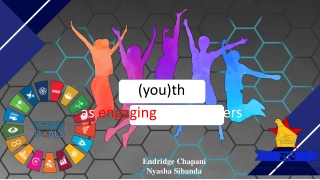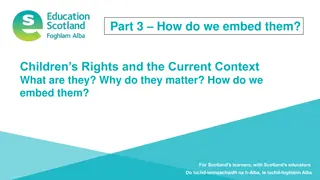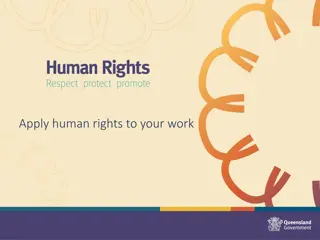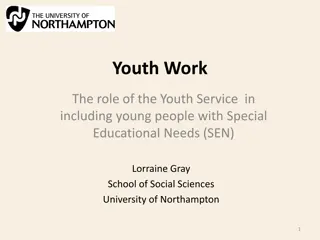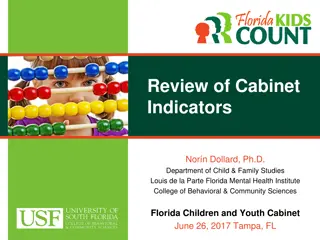
Special Education Basics: Understanding IEP and 504 Plans
Learn about special education basics including Individualized Education Program (IEP) and 504 Plans. Explore what qualifies a student for these plans and the differences between them. Understand the importance of providing accommodations for students with disabilities in the educational environment.
Download Presentation

Please find below an Image/Link to download the presentation.
The content on the website is provided AS IS for your information and personal use only. It may not be sold, licensed, or shared on other websites without obtaining consent from the author. If you encounter any issues during the download, it is possible that the publisher has removed the file from their server.
You are allowed to download the files provided on this website for personal or commercial use, subject to the condition that they are used lawfully. All files are the property of their respective owners.
The content on the website is provided AS IS for your information and personal use only. It may not be sold, licensed, or shared on other websites without obtaining consent from the author.
E N D
Presentation Transcript
California Alliance of Caregivers Presentation Special Education Basics 1 1
What is Special Education? Individualized supports & services as defined under the Individuals with Disabilities Education Act (IDEA) IDEA is the federal law that requires school districts to provide a free appropriate public education to children who are eligible. The term is FAPE. (20 U.S.C. 1400(d); Ed. Code, 56000.) A FAPE means special education and related services that are available to the student at no charge to the parent or guardian, meet state educational standards, and conform to the Student s IEP. (20 U.S.C. 1401(a)(9).) Special education is defined as specially designed instruction to meet the unique needs of students with disabilities. (20 U.S.C. 1401(a)(29).) 2 2
What is a 504 Plan? A plan that provides accommodations to a Student with a disability in the general education environment What is the purpose of a 504 Plan? To provide accommodations to a Student with a disability What criteria qualifies a Student for a 504 Plan? Under 504, there is no list of "approved" disabling conditions. A person with a "disability" is simply one who (1) "has a physical or mental impairment which substantially limits one or more major life activities," (2) has a record of such an impairment, or (3) is regarded as having such an impairment. 34 C.F.R. 104.3(j)(1). 3 3
What is an IEP? Individual Education Program An IEP May refer to three different things: The Meeting: The IEP is the meeting with teachers, parents, and other service providers (such as speech therapists, school psychologists, etc.) and a representative of the school district The Document: The IEP can also be the document that contains the District s offer of placement and services and/or other changes to the materials and services for the Student The Process: The IEP process is the process of identifying the child as a student with a disability and to determine the services and supports needed to have access to academics 4 4
IEP Eligible Conditions To be eligible for special education, the child must satisfy two conditions: Suffering from a qualifying disability; AND 1. The disability prevents the child from accessing their education. 2. DISABILITIES Autistic like or Autism Specific Learning Disability (SLD) Intellectual Disability (ID) Multiple Disabilities Hearing Impairment (DHOH) Orthopedic Impairment (OI) Visual Impairment (VI) Other Health Impairment (OHI) Speech or language Impairment Deafness Deaf-Blind Emotional Disorder (ED) 5 5
IEP vs. 504 504 Pros Better than nothing IEP Pros Can include written accommodations Can include a Health & Safety Plan Can include some services Helps to identify a student as a person with a disability 504 Cons IEP Cons No FAPE offer Modifications to curriculum without parent knowledge or consent Doesn t have to include services People s perception - stigma Hard to enforce No goals or progress monitoring 6 6
The Student is not on an IEP and I and the Parent think he/she needs assistance, what can the Parent do? Request an assessment, in writing, for identification of a disabling condition under a 504 and an IEP. To make a request for an assessment send a written request, such as in an email, to a school district administrator. (You can usually find the name of the special education director online) 7 7
What happens after the Parent requests an assessment? 1. The school district needs to respond within 15 days with an assessment plan* (this doesn t count days when school is out for more than a week) 2. The Parent has 15 days to respond or sign the plan 3. After the Parent signs the plan and submits it to the District, it has 60 days to conduct evaluations and convene an IEP meeting with parents to review the results of the evaluations and determine eligibility or need for a change in the IEP (this doesn t count days when school is out for more than a week) *The District may deny the Parent s request for an assessment, however they must explain the reason for the decision in writing 8 8
What does the Parent do if the district denies their request for an assessment? The Parent can notify the district in writing of their intent to obtain a independent educational evaluation and that they will be seeking reimbursement from the district for the costs of the assessment The Parent can file a Compliance Complaint with the CA Department of Education The Parent can file for Due Process The Parent can contact an attorney The Parent can do nothing but document the child s struggles (behaviors, refusals to attend school, phone calls from school, keep work samples/tests, etc.) and then request an assessment again once they have more information Educate themselves (ex. look online at Wrightslaw, join groups such as on Facebook for parents with disabilities, attend some parent training sessions which are often free, etc.) then the Parent can decide what the best option would be next 9 9
What Are the Parents Rights? There are certain rights that are key and should be used throughout the IEP process, especially when at odds with the school district: RIGHT TO PARTICIPATE RIGHT TO A PRIOR WRITTEN NOTICE RIGHT TO CONSENT RIGHT TO REFUSE TO CONSENT RIGHT TO AN ASSESSMENT RIGHT TO AN INDEPENDENT ASSESSMENT RIGHT TO ACCESS YOUR CHILD S EDUCATIONAL RECORDS RIGHT TO STAY PUT RIGHT TO FILE A COMPLAINT AGAINST THE SCHOOL DISTRICT RIGHT TO MEDIATION AND/OR DUE PROCESS HEARING 10 10
Right To Participate The Parent must be given opportunities to participate in any decision-making meeting regarding their child s special education program or 504. The Parent has the right to participate in all meetings about their child including, but not limited to, the identification (eligibility), assessment, or educational placement of their child, as well as other matters relating to their child s free and appropriate public education (FAPE) or 504. 11 11
Right to a Prior Written Notice (IEP ONLY) This notice must be given to the Parent when the school district PROPOSES or REFUSES to initiate a change in the identification, assessment, or educational placement of the child with special needs. The school must inform the Parent about proposed evaluations of their child in a written assessment plan within 15 days of the Parent s written request for evaluation. The notice must be understandable and in the Parent s native language or other mode of communication. The notice must contain: Description of the actions proposed or refused by the district. Explanation of why the action was proposed or refused. Description of each assessment procedure, record, or report the agency used as a basis for the action proposed or refused. Statement that parents of a child with a disability have protection under the procedural safeguards. Sources for parents to contact to obtain assistance. Description of other options that the IEP team considered, the reason those options were rejected, and a description of any other factors relevant to the action proposed. 12 12
Right to Consent The parent has the right to be fully informed informed of all information relevant to the activity for which consent is sought, in his or her native language or other mode of communication, prior to consenting. (Emphasis added) fully Points to consider: Definition: An informed decision is a decision made after learning all relevant facts and/or information about the subject matter. SO .. In order for a Parent to be able to make informed decisions informed decisions about their child in an IEP, the Parent must have had the opportunity to review all information, reports, draft of the IEP, and draft of the goals, and have had time to understand them. This allows the Parent to have meaningful participation participation in the IEP meeting. The Parent may want to consider rescheduling the IEP if he/she doesn t receive assessment reports prior to the IEP meeting. The parent has the right to understand and agree to the carrying out of the activity for which his or her consent is sought. Activities for which parent consent must be given include, but are not limited to: Assessments change in services, including decreases, and increases, change in placement all or part of an IEP meaningful 13 13
Right to an Assessment Assessments should: be conducted in all areas of suspected disability be sufficiently comprehensive to assess the student in all areas of suspected disability identify all of the student s deficits, whether or not commonly linked to the disability category in which the child may or may not be classified Upon request the district has 15 calendar days (not including school breaks of five days or more) to provide an assessment plan, unless the parent agrees in writing to an extension Parents have at least 15 calendar days from the receipt of the proposed assessment plan to arrive at a decision Parents have the right to refuse to consent to an assessment plan District must assess AND convene an IEP within 60 days of receiving consent for the assessment (not including school breaks of five days or more) If the District fails to assess in a particular area, the parent has the right to request an IEE to assess the student in that area in order to determine whether the student has a disability as well as the nature and extent of the special education and related services that the student needs (See letter to Baus) 14 14
What should be in the District assessment? The written assessment should give the Parent a clear picture of the child s functioning in all the areas of suspected disability. California Education Code Section 56327 requires that the report shall include, but it is not limited to, all of the following: Whether the student many need special education and related services; 1. The basis for making the determination; 2. The relevant behavior noted during the observation; 3. The relationship of that behavior to the student s academic and social functioning; 4. The educationally relevant health and development and medical findings, if any; 5. 15 15
For the students with learning disabilities, whether there is such a discrepancy between achievement and ability that cannot be corrected without special education and related services; 6. A determination concerning the effects of environmental, cultural, or economic disadvantage, where appropriate; 7. The need for specialized services, materials, and equipment for students with low incidence disabilities; and 8. Federal regulations make it clear that the evaluation must be sufficiently comprehensive to identify all of the child s special education services needed, whether or not commonly linked to the disability category of the child [34 C.F.R. Sec 300.304(c)(6)] 9. 16 16
IEP EVALUATIONS The student must be assessed in all areas of suspected disability including, where appropriate: Health and development Vision Hearing Motor Skills (gross and/or fine motor) Speech and language Cognitive (intellectual) Academic Skills Self Help/Adaptive Skills Orientation and mobility Social and emotional Behavior Transition (if the student is or will be over 16 years old within 1 year) 17 17
Assessment Results Generally, the District is required to convene an IEP Meeting to discuss the results of any assessment within 60 days after receiving the signed Assessment Plan (this does not include breaks from school for a week or longer) The evaluator who conducted the assessment(s) should be present at the meeting to present the results of their evaluation 18 18
Right to an Independent Assessment (IEE) If the Parent disagrees with the results of an assessment conducted by the school district, the Parent has the right to ask for and obtain an independent educational assessment for their child from a person qualified to conduct the assessment at public expense. Was the assessment sufficiently comprehensive? Federal regulations state that the evaluation MUST be sufficiently comprehensive to identify all of the child s special education and related services needs, whether or not commonly linked to the disability category in which the child has been classified. {34 C.F.R. Sec. 300.304(c)(6).} Was it done with more than one test? Was it conducted in the native language? Did the testing include observations in all settings? (ie. on the playground, during lunch, etc.) 19 19
Does the Parent have to allow the district a second chance to do their comprehensive testing? [Letter to Baus, 65 IDELR 81 (February 23, 2015).] When an evaluation is conducted in accordance with 34 CFR 300.304 through 300.311 and a parent disagrees with the evaluation because a child was not assessed in a particular area, the parent has the right to request an IEE to assess the child in that area to determine whether the child has a disability and the nature and extent of the special education and related services that child needs. Under 34 CFR 300.502(b)(2), if a parent requests an IEE at public expense, the public agency must, without unnecessary delay, either: (i) initiate a hearing under 34 CFR 300.507 to show that its evaluation is appropriate; or (ii) ensure that an IEE is provided at public expense, unless the agency demonstrates in a hearing under 34 CFR 300.507 that the evaluation obtained by the parent did not meet agency criteria. 20 20
Questions Does the Parent have to give the district a reason for requesting an IEE? Does the Parent have to use a provider from the list the district provides them? How long does the Parent have to wait until they get the requested IEE? What can the Parent do if they ignore their IEE request? What are the district s options when the Parent requests an IEE? ANSWER: When a parent requests an IEE at public expense, the school district must, without unnecessary delay, either: ensure that an IEE is provided at public expense, OR request a due process hearing if the district believes their assessment was appropriate and disagrees that an IEE is necessary. OR The school district also has the right to establish the standards or criteria (including cost and location) for IEEs at public expense 21 21
Questions Continued What does the Parent do if they ignore their request and they do not file for due process to defend their assessment? Answer: If the district has not responded within a reasonable amount of time to the Parent s IEE request, the Parent can: Provide a 10-day notice of their intent to fund the IEE themselves and will seek reimbursement AND/OR File a compliance complaint with the California Department of Education. http://www.cde.ca.gov/sp/se/qa/cmplntproc.asp 22 22
Parents Right to Access their Childs Educational Record(s) The Parent has the right to inspect, review or receive copies of all of their child s educational records without unnecessary delay, including prior to a meeting about their child s IEP or before a due process hearing. If parents are unable to pay for the copies the Parent can request that the charges be waived. Records must be provided regardless of the ability to pay. Educational records include, but are not limited to: reports cards assessment reports testing protocols IEPs attendance records disciplinary reports service logs The school district must provide the Parent access to records and copies, if requested, within (5) business days after the request has been made orally or in writing. (Education Code Sections 49069 and 56504) It is highly recommended that the requests be made in writing. 23 23
Prior to the IEP Meeting the Parent Should Prepare a folder, binder, or notebook with all the educational documents of their child (include work samples, progress reports, and report cards) Request a copy of the assessments, progress on prior goals, and draft goals that will be reviewed Notify the District in writing that they intend to audio record the IEP meeting at least 24 hours prior to the meeting Ensure they have copies of all progress reports of all prior goals. This should be provided, at a minimum when report cards are distributed Make a short list of their concerns (list major concerns first) 24 24
Upon receipt of the IEP notice, ensure sufficient time is allotted to discuss all issues and if not request more time Ensure all IEP members are present. Excusals or early dismissals must be approved by Parent. Do NOT waive the presence of an essential team member. If the IEP meeting is not convened within legal required timelines, the Parent should NOT sign the extension of time If desired, request an agenda to ensure areas of need are discussed and members are present Understand your child s disability and learning style. Learning style can be an area to assess 25 25
The Meeting the Parent Should Understand the role of each participant Place your recording device in the middle of the table Take notes Keep focused and on-task and keep the meeting on- task Student input & participation, if appropriate Make sure important items or concerns are documented in the team meeting notes or in the parent concerns section of the IEP Is everyone at the meeting that should be present? Parent, regular education teacher, Special education teacher, administrator of the District, qualified profesional(s) to interpret the evaluations Ask questions LISTEN, LISTEN, LISTEN and LISTEN Ask for a break to review assessments that were not given ahead of time, or table that portion of the meeting Do NOT argue Come dressed professionally (this is a business meeting) 26 26
Areas to Cover in an IEP and Key Questions to Answer Parent concerns PLOP (Present Levels of Performance) What is the student doing now? How was this determined? Based on what? How does the student s disability affect the involvement and progress in general education? To what extent, if any, will the student be involved in the general curriculum, or age appropriate activities? Student input Strengths and weaknesses (inside and outside of the classroom and outside of the classroom and adaptive living skills adaptive living skills) Review of assessments Review of prior goals Did the student meet the goals? How do you know? Based on what? Where is the data? Who took the data? You can request copies of the data Why did he/she not meet the goal? What can we do to ensure he/she meets the goal next year? Were there enough services provided? 27 27
Special Factors Discussion Behavior, Communication, Assistive Technology, Visual impairments Necessary assessments to address these areas? Annual Goals What should the student be doing in one year? Reasonably calculated What areas of the general curriculum are affected by the disability? What other academic or functional disability related needs should be addressed? Behavior, motor, social emotional, communication, self help, social, and adaptive Is the goal measurable? The student will To what level? How will these goals be generalized? goals be generalized? How will these 28 28
Measurement and Reporting How will progress toward goals be measured and reported? Who will take the data? How will it be taken? Based on what? Progress needs to be measured to ensure periodic progress monitoring. Measurement should be ongoing with updated evidence the time it is reported to parents. Participation in State and District Assessments Will the student participate in state and district assessments? Will you opt out? Are all of the accommodations and modifications listed on the IEP? 29 29
Transition Transition must be discussed and a transition plan, based on assessed needs, must be developed for the school year in which the student turns 16. Have all age appropriate transition assessments of the student been conducted and documented? Does the IEP specify any NEEDED transition services in: Instruction Related services Employment Post school living objectives Daily living skills And more Community experiences Functional vocational evaluations Parents Rights and Educational Rights been determined BEFORE the age of 18? Read and become informed with Transition to Adult Living. This details best practices on transition before the required age of a transition plan of 16. Transition areas can be addressed earlier than 16 30 30
Functional Skills Examples: Motor skills personal care time and money school/work habits home/community navigation behavior and interpersonal relationships this is an endless list, however pick and choose your areas. Does the school have to address my child s functional/adaptive living skills? Definition: Functional skills refers to purposeful and practical activities in the student s daily environment(s) such as a classroom, community, bus, or lunchroom. Functional performance includes but is not limited to: Routine daily living activities Skills needed for independence and performance at school, in the home, and in the community Skills needed for leisure time Skills needed for post-secondary and lifelong learning 31 31
Special Factors to Consider Behavior(s) Is this student s behavior impacting his/her learning or that of others? If yes, what POSITIVE behavioral interventions, supports, or other strategies could address the behavior? Remember: Many students that lack appropriate social and behavioral skills require direct instruction of appropriate skills (in all areas and across all settings). You cannot just tell them what not to do, you must TEACH them what to do Conduct a functional behavioral assessment with data and observations in ALL settings. Make sure there is access to the BCBA, or behavior specialist, who can consult on the BIP. There may be the need for staff training or modification and changes to the BIP. Consult hours should be included on the services page of the IEP 32 32
Manifestation Determination IEP What is a Manifestation Determination IEP? It is an IEP meeting to determine if a behavior resulting in a suspension or possible expulsion was a manifestation of the Student s disability It is NOT a hearing Questions to Cover: Are there appropriately qualified professionals at the IEP meeting? Did the IEP team, including the Parent, discuss if the behavior was a result of a disability? Did the District convene an Manifestation Determination IEP after ten (10) or more days of suspension or a recommendation for expulsion? Did the IEP team adequately evaluate if the IEP was implemented? 33 33
Goals After identifying student needs, the IEP team works to develop annual goals. Annual goals are written based on current levels and designed to allow the student to be involved in and make progress in the general education curriculum (20 U.S.C. 1414(d)(1)(A)(i)(II); Ed. Code, 56345, subd. (a)(2).) A well written goal must be positive and describe a skills that can be observed and measured. An appropriate goals states: What What? Skills or desired behavior How? How? How or at what level Where? Where? Where or under what conditions When When? By when or on what date will the goal be obtained Who Who? Which staff will be responsible for implementing services in order to achieve the goal, and who will monitor the child s progress toward the goal 34 34
Accommodations and Modifications Accommodations/modifications/supplementary supports Modifications: California Education Code Section 60850 (f) (5) Modification means any variation in the assessment environment or process that fundamentally alters what the test measures or affects the comparability of scores. Accommodation: An accommodation is any variation in the assessment environment or process that does not fundamentally alter the curriculum or standard. NOTE: Any accommodation should be implemented with the least amount of support to enhance the student s independence. The goal should be for the student to learn it and do it on his own, if possible. http://www.cde.ca.gov/ta/tg/ha/accmod.asp 35 35
What is ESY and What is it Not? It is based only on the individual student's specific and unique needs that are critical to his/her overall educational progress as determined by the IEP team Designed to maintain student's mastery of critical skills and objectives and achieved during the regular school year Considered a strategy for minimizing the regression of skills Should be provided if the student did not meet his goals It is NOT- An exact replication of the services in the IEP. The special education and related services offered during the extended year period are comparable in standards, scope and quality to the special education program offered during the regular academic year. Participation in ESY is at the discretion of the parents and it is NOT mandatory. It should NOT be denied due to lack of evidence. 36 36
How do we determine the need for ESY? Data, data, data (OBJECTIVE). Data collected during the previous year(s) to determine the student s need. Most students regress, but it is important to discuss how much the student regressed and how quickly the student recoups in comparison to his/her peers. Recommended times for ESY data collection: At the end of the regular school year At the end of the regular summer break At the beginning of the school year Before and after school vacations Reconvene after 3 months after new data has been taken to review as a team or core team members. 37 37
Statement of Services/Services Page Has the IEP team considered what is needed to enable student to be meaningfully educated with non-disabled peers and progress in the general education curriculum to the MAXIMUM extent possible? What does the student need (ie. services, accommodations, aide) for the student to progress? Has the IEP clearly described the following for each service? Frequency and amount (time per scheduled session) Location of service (classroom, speech room, push in) Duration of service (should include beginning and ending dates) How will service be given? (1 to 1; in group; consultative, classroom integrative service) 38 38
Placement & Services Some examples: Some examples: Regular education with resource services (pull out) Special Education classroom (for all or part of the day) Paraprofessional or aide support Individual instruction Non public school BEWARE: Specialized academic instruction Least Restrictive Environment Least Restrictive Environment Placement of student must be in the least restrictive environment. Special education is not a specific place rather services that can be delivered in different locations. The IEP team must ensure that students have the maximum opportunity to be educated with children without disabilities in academic, non academic, and extracurricular activities. 39 39
Related Services Services include, but are not limited to: Services include, but are not limited to: Training and counseling for parents Audiological Services Interpreter Services Orientation and Mobility Services Speech and language therapy Health Services in the school and/or school nurse services Social/counseling services in school Psychological Services Assistive Technology Physical Therapy Occupational Therapy Transportation (regular, curb to curb, door to door etc .) Behavior Services 40 40
Supplementary Aids and Services Adaptive Equipment Modified or Accommodated Academic Materials Assistive Technology such as word processor or a communication system Staff, Student, and/or Parent Training Visual Schedule Breaks during the day Sensory Diet Note taker Adapted materials such as large print, braille books, books on tape/cd Collaboration/consultation between staff, parents, and other professionals (this can include daily and/or weekly communication between home and school) 41 41
Before the Parent Leaves the Meeting Get an offer of FAPE If this is an eligibility IEP then the Parent should agree to eligibility Get a copy of the IEP and ask them to pdf the Parent a copy Get a copy of all the assessments If you are continuing the IEP because the IEP is not finished, get a date when it will continue, INCLUDING the important related services providers After the meeting, following up with emails on conversations to the IEP team and/or members 42 42
Right to Refuse Consent Parents have the right to: Refuse to consent to an assessment Refuse to consent to a placement Consent in part or not consent to parts of an IEP Revoke consent to any part of the IEP Authorize in part, or in its entirety, the IEP 43 43
QUESTIONS What does the Parent do if their child has behavioral issues at school? Request an IEP Meeting Request a Behavior Intervention Plan (BIP) Request a Functional Behavior Assessment (FBA) 1. 2. 3. Can the IEP include a plan for communication between the Parent and Teacher? Yes, this should be listed on the supplementary aids and accommodations and it can be as often as daily, if needed Can the District suspend my child for behaviors related to his/her disability? Yes, but see the first question above Does my child with medical needs require a health care plan to get appropriate special education services? Not necessarily but it would be a good idea to have one What do I do at the beginning of the year to help my child s new teacher understand his/her needs and IEP? You can provide a copy of the IEP and schedule a quick meeting with the teacher to discuss how you can help them understand your child s needs and implement the IEP. This is a good time to find out if the teacher requires any additional supports which you can then request an IEP meeting and ask for those supports/services to be added to the IEP 44 44
The District seems like they are being cooperative and providing the child what they need but how does the Parent know if their child is receiving a FAPE? Is the child meeting their goals? Has the child had the same goals for more than one year? Is the child meeting standards on state standardized tests? Is the child meeting grade level common core standards? Is the child making progress academically, socially, emotionally, and behaviorally from year to year? Are there services the child needs, which the Parent is obtaining outside of school, that the District refuses to offer or has not offered? (ex. Counseling, tutoring, speech, occupational therapy etc.) Is the child missing school due to emotional and behavioral deficits and the District keeps saying it is a home issue? 45 45
When should the Parent contact an attorney? The District has given the Parent an offer of FAPE, it is not appropriate and there is no further room for discussion or changes 1. The child is being expelled 2. The child is not making progress on goals or in the classroom 3. The child is not receiving all required services 4. The child is not offered an appropriate educational placement 5. The District refuses to assess or refuses to fund an IEE 6. The child is in danger or has been physically or emotionally abused at school 7. 46 46
THANK YOU VERY MUCH FOR ATTENDING Christian Knox Ruderman & Knox, LLP www.rudermanknox.com (916) 563-0100 47 47

